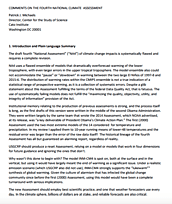NA4 uses a flawed ensemble of models that dramatically overforecast warming of the lower troposphere, with even larger errors in the upper tropical troposphere. The model ensemble also could not accommodate the “pause” or “slowdown” in warming between the two large El Niños of 1997–8 and 2015–6. The distribution of warming rates within the CMIP5 ensemble is not a true indication of a statistical range of prospective warming, as it is a collection of systematic errors. Despite a glib statement about this Assessment fulfilling the terms of the federal Data Quality Act, that is fatuous. The use of systematically failing models does not fulfill the “maximizing the quality, objectivity, utility, and integrity of information” provision of the Act.
Institutional memory relating to the production of previous assessments is strong, and the process itself is long, as the first drafts of this version were written in the middle of the second Obama Administration. They were written largely by the same team that wrote the 2014 Assessment, which NOAA advertised, at its release, was “a key deliverable of President Obama’s Climate Action Plan.” The first (2000) Assessment used the two most extreme models of the 14 considered for temperature and precipitation. In my review I applied them to 10-year running means of lower-48 temperatures and the residual error was larger than the error of the raw data itself! The historical lineage of the fourth Assessment has all but guaranteed an alarming report, regardless of reality.


